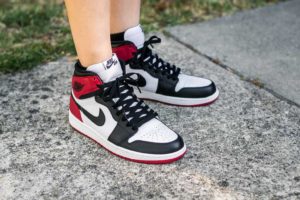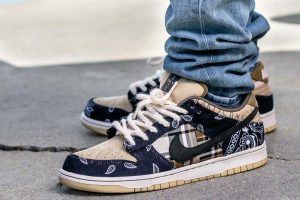Sneaker collecting, once a popular subculture, has gone through some interesting changes, making people wonder if it’s still as popular as before. In this article, we explore the world of sneakerheads to answer the question: “Is sneaker collecting dead?” I’ll get into how sneaker collecting started, how it changed over time, and what the future might hold for the hobby.
The Sneaker that Started it all
Sneaker collecting began in the ’80s and ’90s when brands making sneakers that were great for sports and looked dope! Probably the most well-known early example of collectible sneakers is the Air Jordan 1.

The Air Jordan 1 is often credited as being the first “collectible” sneaker
While the Air Force 1 first released in 1982, the sneaker often credited with igniting sneaker collecting is the Air Jordan 1. Originally released in 1985, the Air Jordan 1 was Michael Jordan’s first signature shoe.
This sneaker broke the mold of traditional basketball kicks with its colorways and high-top silhouette. But the thing that made J1s stand above the rest was the “Be Like Mike” campaign that helped sell the sneaker.
Sneakerheads love owning special and fashionable kicks. Limited releases, unique colorways, and special collabs with shops, artists and designers eventually turned the Jordan 1 into a collectible, laying the foundation for the hobby.
The sneakers’ significance in sneaker culture cannot be overstated. The combo of athletic performance, cutting-edge design, and cultural impact created an unprecedented demand for sneakers in general. Decades later, the Air Jordan 1’s appeal endures, with new new colorways and collaborations continuing to captivate collectors.
The Hype Around Sneaker Releases
These days, part of the appeal of sneaker collecting is the excitement around new releases. Oversaturation can kill this hype.

The hype around these was crazy when they
released. I’ve never seen anything like it.
Shop SB Dunks: eBay
Limited-edition shoes such as the AJ1, when released with clever marketing and interesting stories, create a buzz. You can see hype begin to take shape on social media platforms like Twitter, Tiktok and Instagram. If done correctly, some sneakerheads will want to get their hands on yet another sought-after sneaker.
An unintended consequence is that as more people want these exclusive shoes, brands continue making more of them, which makes them less rare and less exciting for collectors.
While some say that sneaker collecting’s “dead” due to this lack of excitement, that’s not exactly the case. Sneaker companies try their best to release sneakers that are going to gain hype and sell, and this can lead to overproduction of certain pairs, but not necessarily at the volume needed to kill the hobby off entirely.
Fake Sneakers Are A Factor
As sneaker collecting has become more popular, fake sneakers have become increasingly prevalent. Whereas fake kicks were pretty obvious back in the day, these days, reps look almost identical to the real thing, making it challenging for collectors to know if they are getting authentic products.
For a long time, these replica kicks were looked down upon within the sneaker collecting community. While that is still the case for some, with some authentic pairs costing astronomical sums of money on the aftermarket, one can see why some sneakerheads actually have begun seeking out reps as opposed to bashing them. These days there are entire accounts, forums, subreddits, etc dedicated to discussing inauthentic pairs.
The effect on sneaker collecting overall is unknown, however one could say that the increased odds of receiving a fake, particularly a really good one that even passes inspection on an aftermarket site, has diluted some collectors faith in grabbing sneakers they missed out on. If you are a die hard “the sneaker MUST be authentic” type of collector, then you might view the proliferation of reps as a sign that sneaker collecting’s “dead”.
On the other hand, those that wear reps might feel that it is just another way to be into sneakers, appreciating models and colorways that they love at a fraction of the cost. At the end of the day, the hobby is evolving over time. The fact that people still debate on the topic of buying replicas shows that the community is still passionate, whichever side they take.
Resale Market Changes
The resale market, where people sell sneakers they own, was for a time a good indicator of a sneaker’s popularity and value. Rare sneakers sold for high prices. But as the market has stabilized, some sneaker prices have stopped skyrocketing

Limited Air Force 1s do not guarantee high
resale prices. Same with lots of other limited
kicks these days.
Shop Air Force 1s: eBay
This seems to be indicating a shift in how people buy and sell sneakers. Sites like eBay, still to some degree reflect market rates for sneakers.
However, people aren’t as into paying the overinflated prices as they perhaps once were. Be it a shrinking economy, high price fatigue or just on principle, people aren’t as ready to overpay for a sneaker. The prestige of paying full resale prices on a super expensive sneaker doesn’t bring the same feeling as grabbing them for retail on release date did.
Values Change Over Time

Here’s a modern take on an old classic. Newer
aesthetics are ever more important to younger
collectors.
Shop for Nike Dunks on: eBay
As sneaker collecting evolves, a noticeable shift has emerged with younger collectors. Given that newer sneakerheads don’t have the same nostalgia for certain pairs, some veer away from the traditional allure of classic sneakers and colorways. Instead, those types of collectors gravitate towards the excitement of newer trends.
The influence of social media has undeniably played a pivotal role in shaping this new collector mentality. The emphasis on these platforms for some has shifted to owning the most cutting-edge sneakers rather than revering “the classics”. The growing dominance of newer trends among a newer generation of collectors showcases the ever-changing and dynamic nature of sneaker collecting.
That said, there are still those who appreciate the heritage and craftsmanship of classic sneakers among newer and older collectors alike. While sneaker collecting doesn’t look how it did a decade ago, it still perseveres as a popular hobby, as there are releases to please every type of collector.
So, Is Collecting Dead?
I can’t say that sneaker collecting’s dead, but rather a hobby that keeps changing with the times. While some aspects have shifted, the passion for unique, rare kicks remains strong. Collectors still hunt for special releases and some still cherish classic kicks. As the industry moves forward, this hobby will likely remain a key part of fashion and streetwear culture.
